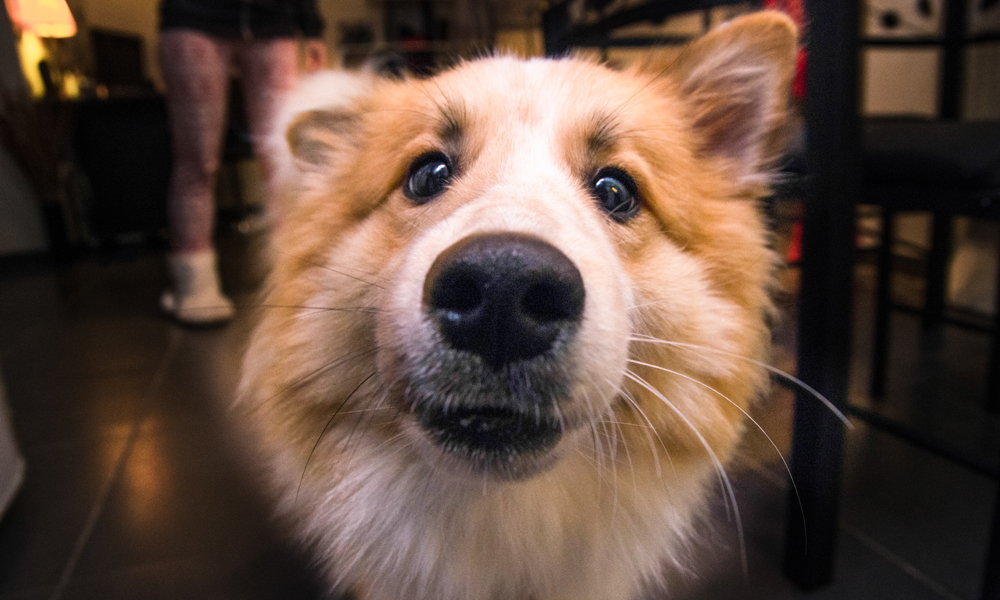Dogs live their lives low to the ground, and that means their faces are close to everything: grass, backyard creatures, furniture, their human’s legs and feet, the robo-vac. The whiskers that poke out from the dog’s muzzle, the sides of the face, and above the eyes do a lot to help your dog get around their world.
Whiskers are connected to highly sensitive nerve endings, guiding their movements, keeping them from getting bumped or poked, and helping them process their surroundings.
What do dog whiskers do?
Dog whiskers sometimes resemble stiff wild hairs, the kind that pop up randomly on Uncle Ed’s brow. But unlike human whiskers, those on canines are functional.
In a zoological context, whiskers are called the more descriptive term vibrissae, deriving from vibrare (“to vibrate” in Latin).
The root of the whisker goes deep under your dog’s skin. At the follicle, there are clusters of highly perceptive nerves. So if something meets the whisker — movement, pressure, contact with an object, an air current — the nerves detect the vibration and relay information to the brain.
Warning system
Whiskers are your dog’s early warning system, telling your dog to stop or back up before they get poked in the face by a protruding stick or bump into the wall. Lightly touch the dog’s whiskers above the eye, and you’ll see how that activates a reflex to slam their eye shut.
Spatial awareness
Whiskers also provide spatial awareness, whether they’re going room to room, or snuffling through a new thicket in the woods. Whiskers help your dog gauge whether a narrow passage is wide enough to accommodate its body. With the help of their whisker guides, they avoid getting stuck. Or, if they’re indoors, whiskers keep them running into walls or knocking over chairs and objects.
Radar detection
Tactile canine whiskers are likened to a tactile radar system, gathering subtle cues from their surroundings.
The nerves are sensitive enough to detect a speck of dust, prompting your dog’s shake- off at seemingly random times.
This sensory system also picks up faint air currents produced by their movements. As they approach a new object, the current bounces off the new surface and is detected by the whisker system, alerting your furry friend that something has changed.
Air currents also aid your dog when pursuing prey. When your dog gets close, those whiskers are picking up air currents from the galloping rabbit. And these little currents provide navigation to keep your dog locked in as the rabbit dodges and pivots.
Do dogs get whisker fatigue?
Felines are known to get overwhelmed by excess contact with the whiskers, which is why pet parents find that fixes like providing a wider, shallower food bowl offer relief.
Most dogs, however, seem to go through life unfazed by the constant stimulation from their whiskers. But it is wise to remember, the muzzle is a highly sensitive area with a cluster of nerve endings. Use a gentle touch and take care to avoid bumping the “snoot” area.
What happens if your dog’s whiskers get cut off?
Whisker loss can happen to dogs by accident, such as getting singed or caught.
Some pet parents ask their groomer to give them a trim. Unlike the tidy, precise rows on a cat’s face, dog whiskers can look wild and unruly. But cutting your dog’s whiskers is not recommended.
Does it hurt the dog when its whiskers get cut?
Since the hair itself has no nerves, losing a whisker is painless for the dog, as long as they’re not pulled out at the sensitive follicle areas.
How do dogs get around without whiskers?
Your dog would really miss having their whiskers. Whiskers provide your dog with spatial awareness more than we may realize. Though canine vision is excellent at detecting new movement and objects in the dark, it’s also blurrier than human vision and they lack our range of color vision.
Read: How do dogs see?
If something happens to their whiskers, you may notice a change in their demeanor as they make their way around, especially when exploring the outdoors or visiting new places.
Do dog whiskers grow back?
The good news is that most dogs can regrow their whiskers within four months after the fact, though not always.
Make mealtime exciting with NutriSource
Appeal to your dog’s keen senses with a healthy wet entrée from NutriSource. Serve it alone or as a kibble enhancement, and your dog will eagerly dive into those yummy meaty bites of chicken, fish, and lamb.
You’ll love that our entire line of wet food is made in our new state-of-the-art facility in Delano, Minnesota. From prep to packaging, family-owned NutriSource handles every step!
Shop local and buy NutriSource from an independent pet supplier in your community.


